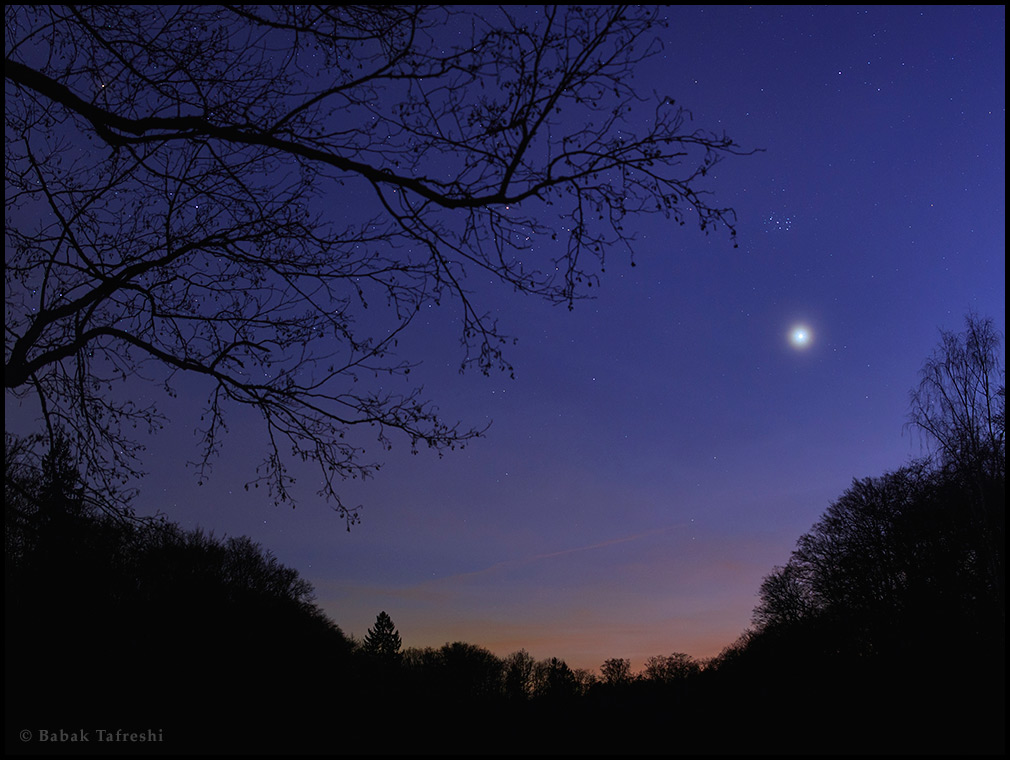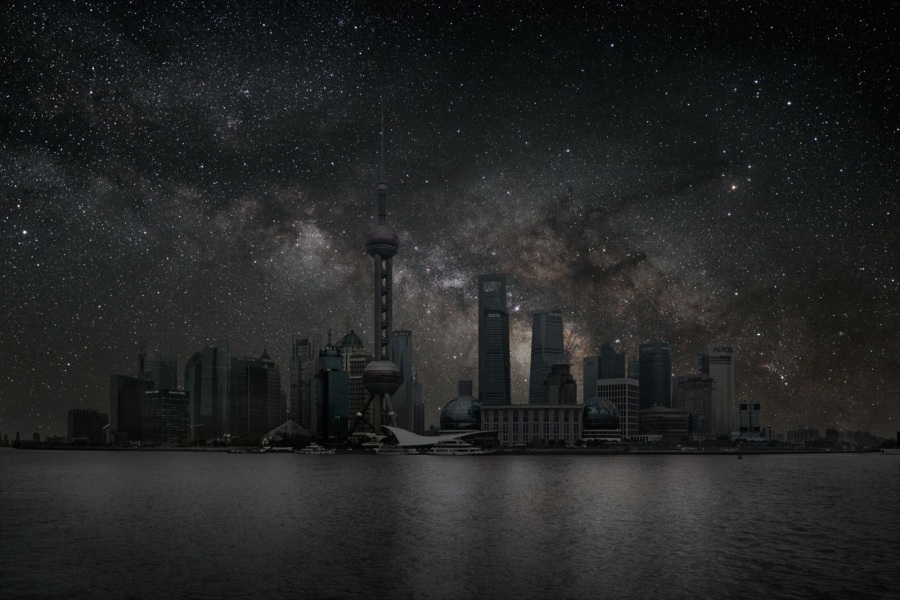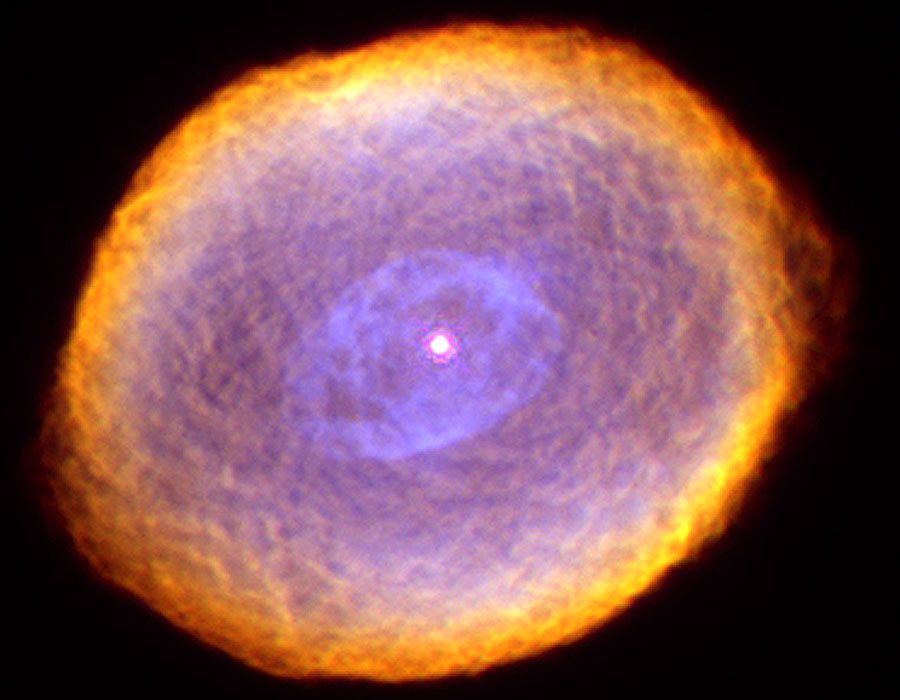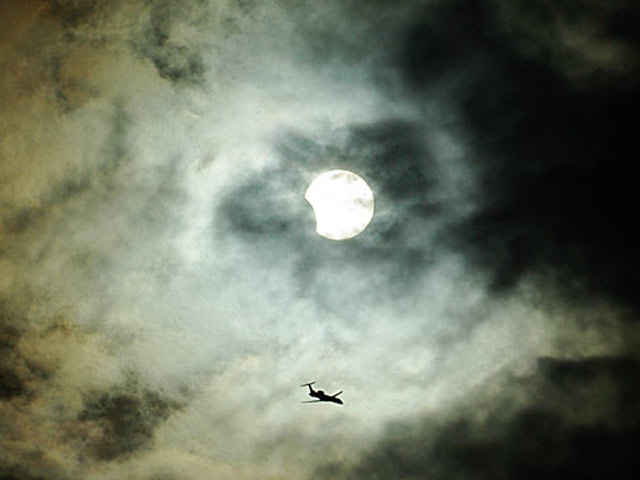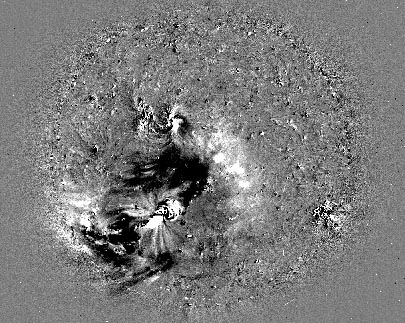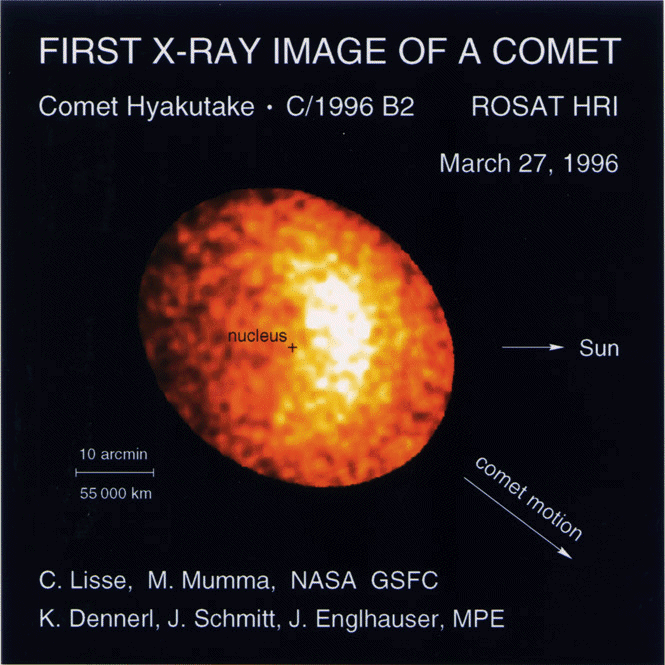| << Previous | Index | Next >> |
2015 In the coming days, Venus shines near the western horizon at sunset. To find Earth's sister planet in twilight skies just look for the brilliant evening star. Tonight very close to the Pleiades star cluster, Venus dominates this springtime night skyscape taken only a few days ago near the town of Lich in central Germany. Also known as the Seven Sisters, the stars of the compact Pleiades cluster appear above Venus in this picture. The budding tree branches to its left frame bright star Aldebaran, the eye of Taurus the Bull, and the V-shaped Hyades star cluster.
2014 Tonight Mars is between opposition (April 8) and closest approach (April 14) looping through the constellation Virgo opposite the Sun in the night sky. That makes it prime season for telescopic views of the the Red Planet, like this one from April 3rd. The clear, sharp image was captured with a high-speed digital camera and 16-inch diameter telescope from Assis, Brazil, Planet Earth. Mars' north polar cap is at the top left. Also visible are whitish orographic clouds - water vapor clouds condensing in the cold atmosphere above the peaks of Mars' towering volcanos. The exact dates of closest approach and opposition are slightly different because of the planet's elliptical orbit. Still, get your telescope out on the night of closest approach (April 14/15) and you can view both Mars and a total eclipse of the Moon. Mars will be about 1/100th the angular size of the Moon.
2013 In a haunting vista you can never see, bright stars and the central Milky Way rise over the dark skyline of metropolitan Pudong in Shanghai, China. Looking east across the Huangpu River, the cityscape includes Pudong's 470 meter tall Oriental Pearl Tower. The night sky stretches from Antares and the stars of Scorpius at the far right, to Altair in Aquila at the left. To create the vision of an unseen reality, part of a series of Darkened Cities, photographer Thierry Cohen has combined a daytime image of the city skyline with an image matched in orientation from a dark sky region at the same latitude, just west of Merzouga, Morocco. The result finds the night sky that hours earlier also arced over Shanghai, but drowned in the lights of a city upon the sea.
2012
Video Credit & Copyright: Michael Kunze
2011 What would a sunrise look like on another world? So far, humanity has only recorded sunrises on Mars and Earth, but it is fun to wonder what they would look like on planets known and yet unknown. Planets far from their parent star would record the rise of an unusually bright point of light rather than a round orb. Although this might appear to be what is pictured above, the careful combination of long exposures and creative lighting is actually based on Venus-rise from planet Earth a few weeks ago, captured through Mesa Arch in Canyonlands National Park, Utah, USA. Picturesque buttes and mesas dot the background landscape. The orange sky is created by air scattering and dust, but is likely reminiscent of dusty skyscapes on Mars. Sunrise was set to occur a few minutes hence, and did indeed involve a round orb.
2010
2009 Intricate, glowing nebulae that shine in planet Earth's night sky are beautiful to look at in deep images made with telescopes and sensitive cameras. But they are faint and otherwise invisible to the naked-eye. That makes their relative location and extent on the sky difficult to appreciate. So, consider this impressive composite image of a wide region of the northern winter sky. With a total exposure time of 40 hours, the painstaking mosaic presents a nebula-rich expanse known as the Orion-Eridanus Superbubble above a house in suburban Boston, USA. Within the wide and deep view are nebulae more often seen in narrower views, including the Great Orion Nebula, the Rosette Nebula, the Seagull Nebula, the California Nebula, and Barnard's Loop. The familiar constellation of Orion itself is just above the foreground house. Brightest star Sirius is left of the roof, and the recognizable Pleiades star cluster is above the tree at the right. A version of the big picture that includes simple constellation guidelines is available here.
2008 At first, he couldn't see it, but searching with binoculars along a cloudy western horizon near sunset, photographer Laurent Laveder finally spotted a delicate lunar crescent. Captured in this dramatic picture on April 6th from Bretagne, France, the Moon was only 15 hours and 38 minutes old. Its slight, irregular, sunlit arc opens upward just above the dark cloud bank near picture center. Of course, a crescent Moon in the early evening sky is a lovely sight often enjoyed by many. But finding the Moon when its slim crescent is still less than about 24 hours past the New Moon phase requires careful timing and planning, a challenging project even for experienced observers. In this sighting, only about 0.8 percent of the Moon's disk appears illuminated. Laveder notes that this is the youngest Moon he has spotted in twenty years of skygazing and also offers this animation (Flash or gif) based on his images of the tantalizing celestial scene.
2007
2006 Have you ever seen a halo around the Sun? This fairly common sight occurs when high thin clouds containing millions of tiny ice crystals cover much of the sky. Each ice crystal acts like a miniature lens. Because most of the crystals have a similar elongated hexagonal shape, light entering one crystal face and exiting through the opposing face refracts 22 degrees, which corresponds to the radius of the Sun Halo. A similar Moon Halo may be visible during the night. The picture was taken in Gunlock, Utah, USA. A flock of birds was caught by chance in the foreground. Exactly how ice-crystals form in clouds remains under investigation.
2005 How can part of the Sun just disappear? When that part is really hiding behind the Moon. Last Friday, the first partial solar eclipse of 2005 and the last total eclipse of the Sun until March 2006 was visible. During a solar eclipse, the Sun, Moon and Earth are aligned. The total solar eclipse was primarily visible from the Southern Pacific Ocean, while a partial solar eclipse was discoverable across South America and lower North America. The above image composite was taken with a handheld digital camera last Friday. After a day of rain in Mt. Holly, North Carolina, USA, a partially eclipsed Sun momentarily peeked through a cloudy sky. After taking a sequence of images, the best eclipse shot was digitally combined with a less good eclipse shot that featured a passing airplane.
2004 In Jules Verne's science fiction classic A Journey to the Center of the Earth, Professor Liedenbrock and his fellow explorers encounter many strange and exciting wonders. What wonders lie at the center of our Galaxy? Astronomers know of some of the bizarre objects that exist there, like vast cosmic dust clouds, bright star clusters, swirling rings of gas, and even a supermassive black hole. Much of the Galactic Center is shielded from our view in visible light by the intervening dust and gas, but it can be explored using other forms of electromagnetic radiation. This haunting wide angle image of the Galactic Center region in infrared light was constructed using data from the Midcourse Space Experiment (MSX) satellite. The image maps three mid-infrared bands, otherwise invisible to human eyes, into visible blue, green, and red colors revealing the thermal emission from dust clouds near the galactic center that have been heated by starlight. The galactic plane runs along the middle of this image while the galactic center itself is the bright spot at picture center. The field of view of this cropped picture is about 1.5 by 2.5 degrees.
2003 Do you recognize this intriguing globular cluster of stars? It's actually the constellation of city lights surrounding London, England, planet Earth, as recorded with a digital camera from the International Space Station. Taken in February 2003, north is toward the top and slightly left in this nighttime view. The encircling "London Orbital" highway by-pass, the M25 (... but not Messier 25), is easiest to pick out south of the city. Even farther south are the lights of Gatwick airport and just inside the western (left hand) stretch of the Orbital is Heathrow. The darkened Thames river estuary fans out to the city's east. In particular, two small "dark nebulae" - Hyde Park and Regents Park - stand out slightly west of the densely packed lights at the city's core.
2002 What happens when galaxies collide? One of the best studied examples of the jumble of star clusters, gas, and dust clouds produced by such a cosmic train wreck is the interacting galaxy pair NGC 4038 / NGC 4039, the Antennae Galaxies, only sixty million light-years away. In visible light images, long, luminous tendrils of material seem to reach out from the galactic wreckage, lending the entwined pair an insect-like appearance. But this penetrating view from the new Wide-field InfraRed Camera (WIRC) attached to the Palomar Observatory's 200 inch Hale telescope shows, in false-color, details of some otherwise hidden features. The large central nuclei of the two original galaxies dominate the near-infrared scene speckled with other bright sources which are themselves giant, newly formed star clusters. Remarkably the northern (topmost) nucleus, obscured in optical images, is also revealed here to have a barred, mini-spiral structure reminiscent of many "single" spiral galaxies.
2001 The largest sunspot group of the past ten years crossed the surface of the Sun late last month and early this month. The group was designated Active Region 9393 as it was the 9393rd region identified since counting officially began in 1973. The number of active regions on the Sun is high recently because the Sun is reaching the maximum of its current 11-year cycle of magnetic activity. The above time-lapse sequence shows AR 9393 as it evolved from 27 March to April 2 to become over 10 times larger than our Earth. Just after the end of the movie, on April 2, AR 9393 unleashed the largest solar flare of the last 25 years. Luckily, the flare was not pointed toward the Earth, or flare particles might have damaged satellites or even caused local electrical blackouts. Yesterday morning, however, a less powerful flare was ejected from a different sunspot group (AR 9415) toward Earth that has already caused radio interference. This and solar activity from Monday should cause significant aurorae over the next two nights. Will the above sunspot group remain as its region rotates back into view in a few days, or will it break up on the far side of the Sun? Currently, no one knows for sure.
2000 The stars are not alone. In the disk of our Milky Way Galaxy about 10 percent of visible matter is in the form of gas, called the interstellar medium (ISM). The ISM is not uniform, and shows patchiness even near our Sun. It can be quite difficult to detect the local ISM because it is so tenuous and emits so little light. This mostly hydrogen gas, however, absorbs some very specific colors that can be detected in the light of the nearest stars. A working map of the local ISM within 10 light-years based on recent observations is shown above. These observations show that our Sun is moving through a Local Interstellar Cloud as this cloud flows outwards from the Scorpius-Centaurus Association star forming region. Our Sun may exit the Local Interstellar Cloud during the next 10,000 years. Much remains unknown about the local ISM, including details of its distribution, its origin, and how it affects the Sun and the Earth.
1999 On April 12, 1981, space flight entered a new era with the first launch of Space Shuttle Columbia. NASA's Space Shuttles land like a normal airplane, carry a heavy cargo, carry a large crew, make use of cheap solid fuel, and are reusable. Previous to this flight, no manned orbiting space ship had ever landed on a runway. Space Shuttles now are the flagships and the workhorses of NASA's space going rockets.
1998 Scattered within this cavernous nebula, cataloged as NGC 604, are over 200 newly formed hot, massive, stars. At 1,500 light-years across, this expansive cloud of interstellar gas and dust is effectively a giant stellar nursery located some three million light-years distant in the spiral galaxy, M33. The newborn stars irradiate the gas with energetic ultraviolet light stripping electrons from atoms and producing a characteristic nebular glow. The details of the nebula's structure hold clues to the mysteries of star formation and galaxy evolution.
1997 The Earth has once again endured a burst of particles from the Sun. The latest storm, which began Monday, was one of the best documented solar storms to date. At 10 am (EDT) ground monitors of the SOHO spacecraft, which continually monitors the Sun, noticed a weak spot in the solar corona was buckling again, this time letting loose a large, explosive Coronal Mass Ejection (CME). Almost simultaneously, NASA's WIND spacecraft began detecting bursts of radio waves from electrons involved in this magnetic storm. Supersonic waves rippled though the solar corona as a puff of high energy gas shot out into the Solar System. The above image shows two photographs of the Sun taken about 15 minutes apart and subtracted, highlighting the explosion. The CME gas will have little lasting effect on the Earth, but might make this a good weekend to see an aurora.
1996 The first X-rays ever detected from a comet were discovered from Comet Hyakutake with the ROSAT satellite on March 27th. The discovery is particularly surprising because there was little previous indication that comets emit any significant X-radiation. As the comet passed the Earth in late March, repeated observations with ROSAT also showed that the X-ray brightness changed over just a few hours. The crescent shape of the X-ray emission is also enigmatic. One possible explanation is that X-rays emitted from the Sun are absorbed by water in the comet's coma causing fluorescence. Another possible explanation involves interaction with the solar wind - fast moving particles streaming away from the Sun.
| << Previous | Index | Next >> |
